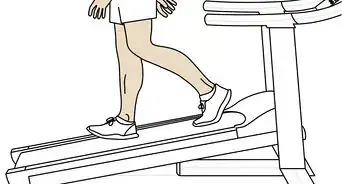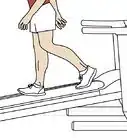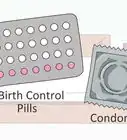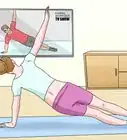This article was co-authored by Laura Marusinec, MD. Dr. Marusinec is a board certified Pediatrician at the Children's Hospital of Wisconsin, where she is on the Clinical Practice Council. She received her M.D. from the Medical College of Wisconsin School of Medicine in 1995 and completed her residency at the Medical College of Wisconsin in Pediatrics in 1998. She is a member of the American Medical Writers Association and the Society for Pediatric Urgent Care.
There are 23 references cited in this article, which can be found at the bottom of the page.
This article has been viewed 267,536 times.
People often equate getting fit with losing weight, but the two are in fact very different things. While weight loss programs look to the numbers to determine success or failure, goals for getting fit involve more holistic criteria such as improving cardiovascular health, strength, and endurance while maximizing life span and self-esteem. It’s not an overnight process, but you can start getting fit right now by learning the essential aspects of fitness: cutting out unhealthy habits, increasing physical activity, eating a balanced diet, and being vigilant about your mental health and self-esteem.
Steps
Changing Old Habits
-
1Cut down on your sedentary activities. Almost everyone has at least one sedentary pleasure, be it binge-watching favorite television shows, playing video games, or surfing the internet on your laptop. Not only do these activities often require you to sit or lay prone as you do them, they have also been shown to cause problems with self-esteem and anxiety in children and teenagers.[1] Getting active doesn’t mean you have to quit all of these enjoyable hobbies, though: you can simply reduce the time you dedicate to these activities rather than cutting them out all together.
- For example, limit your daily television to 2 hours. You can give yourself more time as long as you’re doing something active while at it, such as jogging on the treadmill.
- If you spend too much time online, install a program that blocks problem sites and increases productivity, such as Freedom, Anti Social, and StayFocused.[2]
- You can also give yourself time limits for surfing the web or playing video games. Just make sure that you stick with them.
-
2Stop mindless snacking. There's nothing wrong with snacking on popcorn while watching a movie, but if you do it too often, then it does become a problem. If you suspect that you might be snacking too much, make a diet plan where you allow yourself 1 or 2 snacks per day.[3]
- Choose healthier snacks such as popcorn made without a lot of oil, salt, or butter, or fruits or veggies and a low-calorie dip.
- Salty and sweet junk foods like chips and soda are particularly addictive, so you might want to keep them out of the house altogether.
- Ask your parents to stop buying unhealthy snacks, especially if they don't eat them themselves. Alternatively, you can ask your family to hide unhealthy snacks from you.
Advertisement -
3Quit lazy behaviors. Modern society often encourages lazy behaviors in ways one doesn’t even realize, such as offering escalators in malls, making automotive vehicles the default mode of transport in daily life, and emphasizing convenience through mobile applications, delivery services, and virtual socializing. You can opt out of lots of these behaviors, though, by substituting them with active pursuits.
- Walk whenever possible. If the grocery store is just down the block, there's no reason to take the car, especially if it is nice outside.[4]
- Alternatively, take the stairs instead of the elevator or escalator.
-
4Socialize on the move. Your go-to activity when meeting up with friends might be sharing some apps at the local diner or gabbing on the couch, but you don’t have to limit your social hour to sedentary activities. Next time you’ve set a date to catch up with your pals, go to a nature trail or neighborhood path and take a walk together rather than slouching on the sofa, or play an active video game like WiiFit instead of your usual fare.[5]
- If your friends aren’t into the idea, ask family members if they’d like to go for a walk next time you’re sitting around talking or watching television.
-
5Quit smoking if you are a smoker. Smoking can cause lots of health problems and it can also affect your ability to be physically active. For example, you might find vigorous cardiovascular activities like running, swimming, and dancing are much harder if you are a smoker. If you smoke, talk to your doctor about how to quit. There may be smoking cessation programs in your area that can help.
Getting Active
-
1Create an exercise plan. Regular, well-rounded exercise will benefit you more than sporadic workouts which include only one type of exercise like weight-lifting or running. You should incorporate both aerobic exercise—any activity that uses large muscle groups and can be sustained for at least ten minutes—and strength-conditioning—resistance-based activities which strengthen your muscles through repetition—into your fitness regimen, with aerobic activities taking up more time than strength-training. You can make sure you perform the recommended balance of activities by establishing a workout calendar.
- Make sure you plan your workouts around other, mandatory aspects of your life such as school, work, and family. While fitness is important, it’s only one pillar of your life and shouldn’t cause you to sacrifice other things.[6]
-
2Do aerobic activities. Concerted aerobic exercise enhances your cardiovascular health and endurance while releasing endorphins and elevating your mood. Aim for a minimum of 150 minutes per week, or 30 minutes a day five times a week.[7] You can join a gym to take advantage of aerobics classes and workout machines, or you can go for a more independent approach and take up jogging, walking, or cycling.
- Recent studies have risen doubt as to whether or not stretching beforehand really reduces injury. Still, a 5-minute stretch before exercise is not a bad idea.[8]
-
3Start strength training. In addition to your weekly 150-minute commitment to aerobic exercise, you should complete strengthening exercises at least two days a week. Weight machines, medicine balls, resistance bands, and home workouts—for example, push ups and sit ups—all make great strength training activities.[9]
-
4Work your arms, legs, and core during strength training. Many people make the mistake of doing weight-lifting and other strengthening exercises which only address one part of their body: they’ll do a bunch of arm reps, for example, but ignore their core and legs. Avoid this mistake by making sure you do a mixture of exercises which address all three main muscle groups.
- In order to strengthen your core, do exercises such as sit ups, plank exercises, and crunches. These will strengthen and tone your abdominal and back muscles.
- For your legs, you should do things like squats, vertical jumps, and wall sits. Good arm exercises include pushups, pullups, and lifting dumbbells.
-
5Join a school or community sports team. If you have a difficult time getting and staying motivated during individual workouts, consider joining a sports team. Sports are a fun way to get aerobic exercise and strength training while building strong relationships with other teammates, learning time management, and developing a sense of personal responsibility.[10]
- If you don’t know what sports to try, check out the offerings at your local YMCA and school groups. Try out several sports, then continue the ones you enjoy.
-
6Take a physically active class like dancing or yoga. Team sports aren’t the only way to get active outside of the gym or jogging trail. You can also sign up for classes which teach you a physical activity, such as ballet, yoga, and modern dance are all great examples. See if there’s a yoga or dance studio in your area and then ask your parents if you can afford the monthly fees. Communities often have lower-cost options at local schools, rec departments, gyms, YMCAs, or community centers.
- If you’re interested in yoga, register for a beginner’s class where they’ll provide sufficient instruction. If you try moves that are outside for your level, you can hurt yourself.[11]
Eating Right
-
1Include a variety of fruits and vegetables in your diet. Fruits and vegetables should comprise the biggest portion of your daily diet, but don’t just eat the same two veggies in large quantities. Studies have shown the healthiest way to get your daily five to nine servings of fruits and veg is to eat a wide variety of them.[12]
- Get creative when adding fruits and vegetables to your diet. Mix up new, interesting salads rather than the lettuce, cucumber, and tomato salad.[13]
- Presentation can make a boring meal look appealing. For example, you could arrange fruit slices artistically on a plate to make it look like something from a 5-star restaurant.
-
2Eat whole proteins. In addition to your daily fruit and vegetable intake, you should make an effort to eat plenty of protein. Try to be a bit picky about your proteins, though: go for lean and unprocessed meats such as lean steak and chicken breast rather than regular grade ground beef (containing 75-85% fat), bacon, and sausages.
- If you’re a vegetarian, you can still get your daily intake of protein through foods such as nuts, beans, and eggs.
-
3Strive for balance rather than low calories. Recent studies have shown that emphasizing calorie-counting does little to enhance a healthy diet and can lead to disordered eating habits. After all, if you’re just trying to stay under a prescribed calorie mark, it won’t matter if the foods you eat are largely homogenous and supply minimal nutrition, as long as you duck under your 1,200- or 1,500-calorie goal. Instead, prioritize eating three nutritious, well-rounded meals with high-quality ingredients while keeping non-fruit or veggie snacking to a minimum.[14]
- Avoid diet and low-fat processed foods. Studies have shown that they don't have many nutritional benefits.[15]
-
4Increase your intake of iron and calcium. Teenagers— and girls in particular—are prone to iron and calcium deficiencies, so you should be sure to eat foods rich in these nutrients every day. Dairy products such as yogurt and cheese are high in calcium, a nutrient necessary for bone health and growth, and you should aim to get at least 1,300 milligrams a day. Lean meats, fish, soy, and lentils are some foods particularly high in iron, a nutrient which helps deliver oxygen to your body. You should aim for between 15-25 mg of iron per day.[16]
- Studies have shown that your body absorbs little to no nutrients from supplements. Unless your doctor advises otherwise, get your daily calcium and iron through food.[17]
-
5Cut out processed foods which offer little nutritional value. In addition to eating plenty of healthy, un-processed foods, you should also reduce your intake of processed junk foods such as chips, crackers, fast food, candy, and soda. Such foods often contain harmful chemical additives and preservatives, as well as transfats which raise your cholesterol and increase your risk of heart disease.[18]
- Don’t go overboard and start thinking of these foods as “bad." If you start assigning moral value to food, you risk developing eating disorders and self-esteem problems.[19]
-
6Eat breakfast every day. It can feel impossible to eat breakfast when you’re running out the door every morning to catch the school bus or your car pool, but you should make a special effort to incorporate breakfast into your daily routine. This simple step to fitness encourages healthier eating throughout the day, as well as boosting your metabolism and mood.[20]
- If you just can’t force anything down your throat before you leave for school, take some yogurt and a banana with you to school so that you can eat it a bit later in the morning.
-
7Drink 2.2 liters of water per day. You’ve probably heard your doctor or other health professionals talk about how important hydration is for your health, but you might not realize all the things this miracle of moisture does for you. In addition to flushing toxins out of your organs and delivering nutrients to your cells, water also improves your skin, hair, and nail health.[21]
- Take a water bottle to school with you so that you can sip on it throughout the day. It's better than sporadic trips to the water fountain or soda from the vending machine.
- All fluids contribute to your daily water intake, including juice and tea. Still, it's best to get most of your fluid-intake through pure water, rather than other drinks.
Maintaining Mental Health
-
1Take days off from exercise. In a cultural climate that reveres fitness and specific body types, working out can quickly become destructive obsessions. Becoming too preoccupied with your workout regimen can cause injuries from over-exertion, as well as corrode mental health. By giving yourself rest days when you don’t work out and avoiding daily weigh-ins and weight loss shows like The Biggest Loser, you can take steps to ensure that attending to your body doesn’t jeopardize your mental health.[22]
- If you find yourself feeling guilty or anxious when you don’t work out for a day or two, you might be developing an unhealthy attitude toward exercise. Talk to a parent or school counselor to get help before your problem worsens.
-
2Think of food as a resource and not as an enemy. Eating healthy and getting fit doesn’t mean that you should deprive yourself of food or that you shouldn’t enjoy your meals. The minute you start perceiving food as something to avoid, you start to develop a problematic relationship with food which can last throughout your whole life. Remind yourself that food is essential to life and let yourself indulge in favorite, rich foods often enough that you don’t develop cravings and the impulse to binge.[23]
- If you tend to binge, skip meals, or use laxatives, you might have an eating disorder. Contact a parent, school health official, or doctor in order to address the issue.[24]
-
3Engage in activities unrelated to fitness. If you devote all your time outside of school to working out and attending to your diet, you’re making your self-esteem dependent on fitness. Your latest workout and meal plan shouldn’t define your failures and successes, though; rather, your whole personality, talents, empathy, and relationships with friends and family are what should make you feel good about yourself. Remind yourself of this fact by dedicating plenty of time to activities such as volunteering for local charity organizations, playing an instrument, writing, or painting.[25]
- You can help your friends build self-esteem as well by participating in these activities with them and discouraging any self-deprecating comments when you’re around.
-
4Sleep 8-10 hours every night. Many teenagers don’t get the proper amount of sleep, and, while you may not notice any adverse effects from this deficiency, lack of sleep can affect your life in many ways. It can make you moody, stressed, and less proficient in class, as well as encouraging poor, impulsive eating habits and even leading to facial blemishes.[26]
- In addition to striving for an eight-hour minimum, you should aim for a regular sleep pattern. For example, try to go to bed at a similar time each night and avoid sleeping late on the weekends.
Expert Q&A
Did you know you can get expert answers for this article?
Unlock expert answers by supporting wikiHow
-
QuestionWhat about yoga? Doesn't that make you fit too? If so, which poses should I do?
 Laura Marusinec, MDDr. Marusinec is a board certified Pediatrician at the Children's Hospital of Wisconsin, where she is on the Clinical Practice Council. She received her M.D. from the Medical College of Wisconsin School of Medicine in 1995 and completed her residency at the Medical College of Wisconsin in Pediatrics in 1998. She is a member of the American Medical Writers Association and the Society for Pediatric Urgent Care.
Laura Marusinec, MDDr. Marusinec is a board certified Pediatrician at the Children's Hospital of Wisconsin, where she is on the Clinical Practice Council. She received her M.D. from the Medical College of Wisconsin School of Medicine in 1995 and completed her residency at the Medical College of Wisconsin in Pediatrics in 1998. She is a member of the American Medical Writers Association and the Society for Pediatric Urgent Care.
Board Certified Pediatrician
-
QuestionHow can I keep track of my calorie intake each day?
 Laura Marusinec, MDDr. Marusinec is a board certified Pediatrician at the Children's Hospital of Wisconsin, where she is on the Clinical Practice Council. She received her M.D. from the Medical College of Wisconsin School of Medicine in 1995 and completed her residency at the Medical College of Wisconsin in Pediatrics in 1998. She is a member of the American Medical Writers Association and the Society for Pediatric Urgent Care.
Laura Marusinec, MDDr. Marusinec is a board certified Pediatrician at the Children's Hospital of Wisconsin, where she is on the Clinical Practice Council. She received her M.D. from the Medical College of Wisconsin School of Medicine in 1995 and completed her residency at the Medical College of Wisconsin in Pediatrics in 1998. She is a member of the American Medical Writers Association and the Society for Pediatric Urgent Care.
Board Certified Pediatrician Learn how to read nutrition labels. Make sure you know the portion sizes, and multiply the number of portions of the food times the calories per portion. Write down the foods you eat and how much in a journal to help keep track. You can buy a small scale to weigh your food if you really want to get specific. Check out websites, and especially mobile apps that help you count calories such as: https://www.myfitnesspal.com/
Learn how to read nutrition labels. Make sure you know the portion sizes, and multiply the number of portions of the food times the calories per portion. Write down the foods you eat and how much in a journal to help keep track. You can buy a small scale to weigh your food if you really want to get specific. Check out websites, and especially mobile apps that help you count calories such as: https://www.myfitnesspal.com/
Things You'll Need
- Breathable workout clothes
- Running shoes
- Pen
- Calendar
References
- ↑ https://www.gov.uk/government/news/sedentary-lifestyles-and-too-much-screen-time-affect-childrens-wellbeing
- ↑ https://www.theguardian.com/small-business-network/2014/dec/17/internet-restriction-apps-productivity
- ↑ https://phcuk.org/wp-content/uploads/2016/05/Eat-Fat-Cut-The-Carbs-and-Avoid-Snacking-To-Reverse-Obesity-and-Type-2-Diabetes-National-Obesity-Forum-Public-Health-Collaboration.pdf
- ↑ http://www.helpguide.org/articles/exercise-fitness/easy-ways-to-start-exercising.htm
- ↑ http://www.helpguide.org/articles/exercise-fitness/easy-ways-to-start-exercising.htm
- ↑ http://tinybuddha.com/blog/being-fit-without-letting-food-and-exercise-control-you/
- ↑ http://www.heart.org/HEARTORG/HealthyLiving/PhysicalActivity/FitnessBasics/American-Heart-Association-Recommendations-for-Physical-Activity-in-Adults_UCM_307976_Article.jsp#.WC4cxnfMxxg
- ↑ http://www.nhs.uk/Livewell/fitness/Pages/Do-I-need-to-stretch-before-or-after-a-run-or-sports-and-exercise.aspx
- ↑ http://www.mayoclinic.org/healthy-lifestyle/fitness/in-depth/strength-training/art-20046670
- ↑ http://www.pamf.org/teen/health/sports/
- ↑ http://www.nytimes.com/2012/01/08/magazine/how-yoga-can-wreck-your-body.html
- ↑ http://www.fruitsandveggiesmorematters.org/experts-recommend-5-9-servings-of-fruits-and-veggies-daily
- ↑ http://www.fruitsandveggiesmorematters.org/easy-ways-to-add-fruits-veggies-to-your-day
- ↑ http://www.prevention.com/weight-loss/weight-loss-tips/5-reasons-to-never-count-another-calorie/slide/1
- ↑ https://phcuk.org/wp-content/uploads/2016/05/Eat-Fat-Cut-The-Carbs-and-Avoid-Snacking-To-Reverse-Obesity-and-Type-2-Diabetes-National-Obesity-Forum-Public-Health-Collaboration.pdf
- ↑ https://www.healthychildren.org/English/ages-stages/teen/nutrition/Pages/A-Teenagers-Nutritional-Needs.aspx
- ↑ https://www.healthychildren.org/English/ages-stages/teen/nutrition/Pages/A-Teenagers-Nutritional-Needs.aspx
- ↑ http://www.eatright.org/resource/food/nutrition/nutrition-facts-and-food-labels/avoiding-processed-foods
- ↑ http://mayoclinichealthsystem.org/hometown-health/speaking-of-health/clean-eating-getting-to-the-source
- ↑ http://www.consumerreports.org/cro/magazine/2014/10/why-eating-the-right-breakfast-is-so-important/index.htm
- ↑ http://www.mayoclinic.org/healthy-lifestyle/nutrition-and-healthy-eating/in-depth/water/art-20044256
- ↑ http://kidshealth.org/en/parents/compulsive-exercise.html
- ↑ http://www.huffingtonpost.com/2014/04/17/healthy-relationship-to-food-habits_n_5107037.html
- ↑ http://www.mayoclinic.org/healthy-lifestyle/tween-and-teen-health/in-depth/teen-eating-disorders/art-20044635
- ↑ https://www.healthychildren.org/English/ages-stages/teen/Pages/Ways-To-Build-Your-Teenagers-Self-Esteem.aspx
- ↑ https://sleepfoundation.org/sleep-topics/teens-and-sleep
About This Article
If you're a teenage girl who wants to get fit, getting active can help you build strength, endurance, and self-esteem. Build more activity into your daily life by taking the stairs instead of the elevator or escalator, or walking to errands if they’re not that far away. You can also ask a friend if they want to go for a walk or hike instead of meet at a cafe. When you’re ready to take the next step, create an exercise plan, like 30 minutes of aerobic activity 5 days a week and 2 days a week of strength training. If you have a hard time staying motivated, join a school or community sports team or take a physically active class. For more tips from our Medical co-author, including how to eat right to get fit, keep reading!
-Step-1-Version-2.webp)
-Step-2-Version-2.webp)
-Step-3-Version-2.webp)
-Step-4-Version-2.webp)

-Step-5-Version-2.webp)
-Step-6.webp)
-Step-7.webp)
-Step-8.webp)
-Step-9.webp)
-Step-10.webp)
-Step-11.webp)
-Step-12.webp)
-Step-13.webp)
-Step-14.webp)
-Step-15.webp)
-Step-16.webp)
-Step-17.webp)
-Step-18.webp)
-Step-19.webp)
-Step-20.webp)
-Step-21.webp)




-Step-18.webp)


-Step-30-Version-3.webp)



-Step-26.webp)
















































